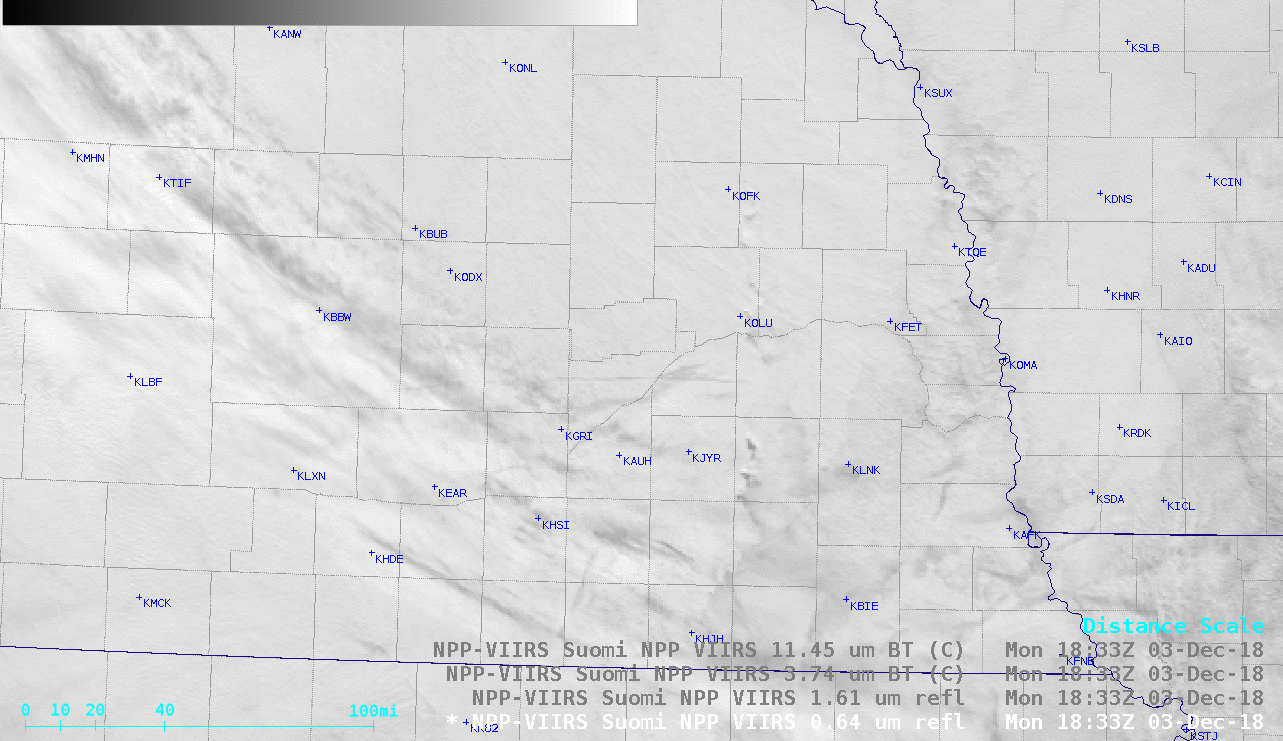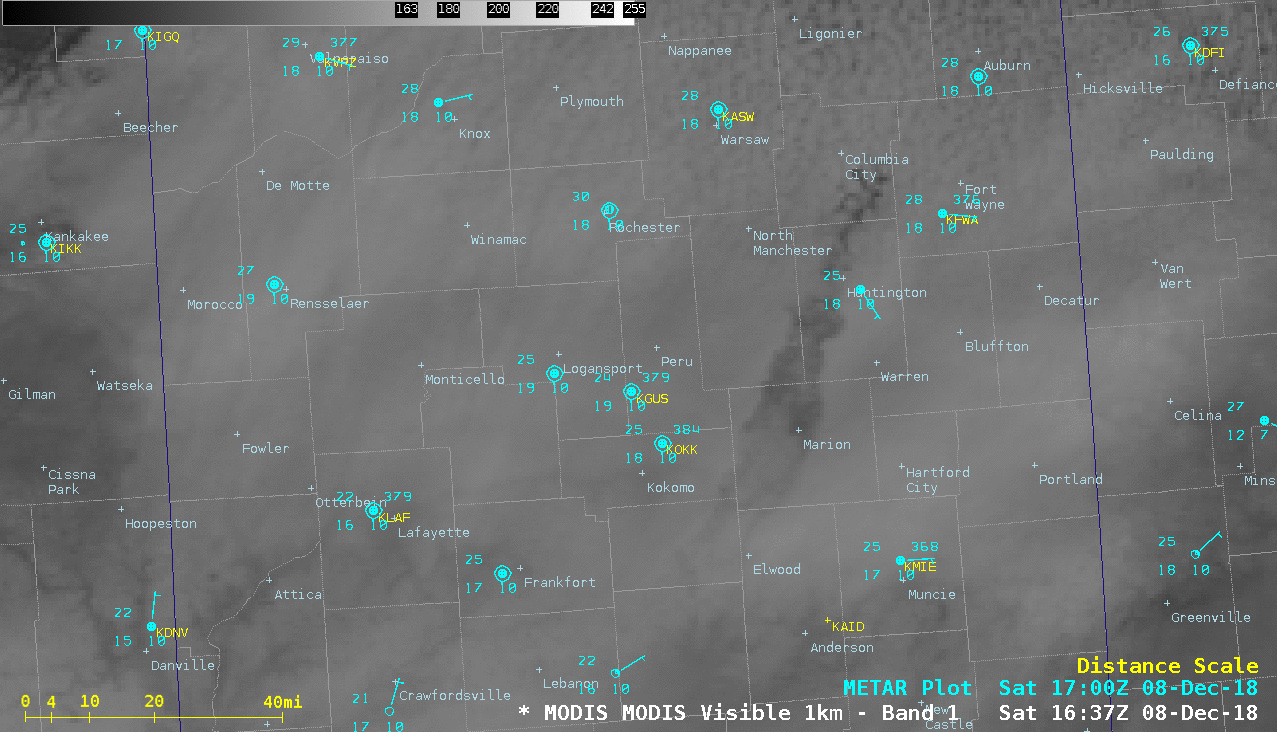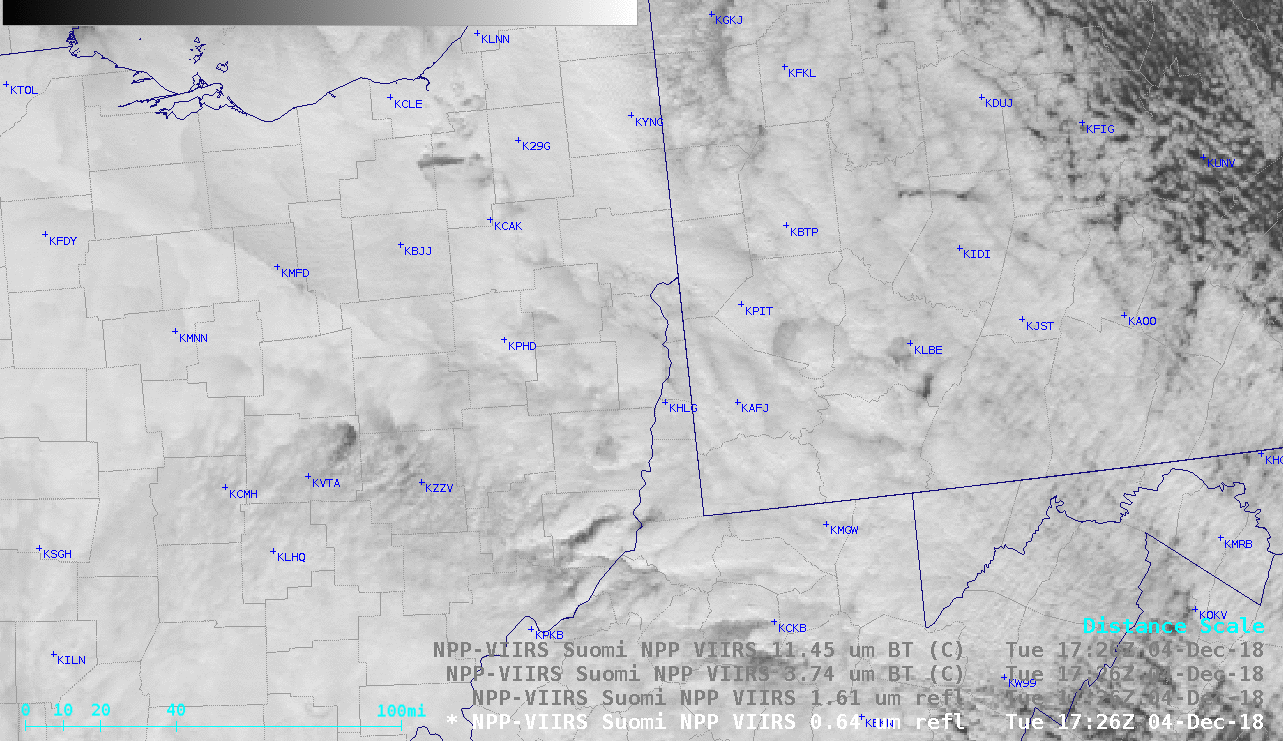Industrial and ship plumes in supercooled clouds
A sequence of nighttime MODIS and VIIRS “Fog/stratus” infrared Brightness Temperature Difference (BTD) images (above) revealed long plumes (darker shades of red) streaming southwestward for over 200 miles from their industrial point sources in the Mesabi Range of northeastern Minnesota on 03 December 2018.During the subsequent daytime hours, a comparison of GOES-16 (GOES-East) “Red” Visible (0.64 µm), Near-Infrared “Snow/Ice” (1.61 µm), Near-Infrared “Cloud Particle Size” (2.24 µm) and Shortwave Infrared (3.9 µm) images (below) showed signatures of these Mesabi Range plumes along with others emanating from industrial or power plant sources. A few ship tracks were also apparent across Lake Superior.
Particles emitted from the exhaust stacks at power plants and industrial sites (as well as ships) can act as efficient cloud condensation nuclei, which causes the formation of large numbers of supercooled water droplets having a smaller diameter than those found within the adjacent unperturbed supercooled clouds — and these smaller supercooled cloud droplets are better reflectors of incoming solar radiation, thereby appearing brighter in the Near-Infrared and warmer (darker gray) in the Shortwave Infrared images.
GOES-16 “Red” Visible (0.64 µm), Near-Infrared “Snow/Ice” (1.61 µm), Near-Infrared “Cloud Particle Size” (2.24 µm) and Shortwave Infrared (3.9 µm) images [click to play animation | MP4]

VIIRS Visible (0.64 µm), Near-Infrared “Snow/Ice” (1.61 µm), Shortwave Infrared (3.74 µm) and Infrared Window (11.45 µm) images [click to enlarge]
It’s been confirmed that this snow band is originating from 2 plants in Norfolk. The steam produced there is essentially acting to add moisture and warmth to the clouds creating the snow. Had reports of large flake and up to 1in. If you live in that area how much have you seen? pic.twitter.com/mSiVcj6uH2
— NWS Omaha (@NWSOmaha) December 3, 2018
Farther to the east over Ohio and Pennsylvania, another example of the 2 plume types was seen (below) — one plume originating from an industrial site near Cleveland was glaciating/eroding the supercooled cloud and producing snowfall, while another bright/warm supercooled droplet plume was moving southeastward from a point source located west of Indiana County Airport KIDI.
#Weather #Nerd Moment! Seeing a very localized enhancement of a band of #snow from industries near downtown #Cleveland. The heat and steam from near downtown #CLE is causing localized snow southeastward towards Summit County. Seen from satellite and radar. #OHwx #PAwx #NWS #CLEwx pic.twitter.com/C1Ojwienqq
— NWS Cleveland (@NWSCLE) December 4, 2018
The Cleveland plume was captured by an overpass of the Landsat-8 satellite, with a False Color Red-Green-Blue (RGB) image viewed using RealEarth providing great detail with 30-meter resolution (below). A small “overshooting top” can even be seen above the industrial site southeast of Cleveland, with the swath of glaciated and eroding cloud extending downwind (to the southeast) from that point.
Coincidentally, Landsat-8 also captured another example of a glaciating cloud plume downwind of the Flint Hills Oil Refinery south of St. Paul, Minnesota on 03 December (below). The erosion/glaciation of supercooled cloud extended as far south as Albert Lea, Minnesota. Similar to the Cleveland example, a small “overshooting top” was seen directly over the plume point source.===== 08 December Update =====
Visible satellite loop of another industrial plant steam plume from Columbia City affecting clouds/weather. Snow reported in Marion IN about 45 miles south. #inwx #Weather pic.twitter.com/KkrTtzPBsd
— Sam Lashley (@Slashman_us) December 8, 2018
The effect of this industrial plume glaciating and eroding the supercooled water droplet clouds over northern Indiana was also seen in a comparison of Terra MODIS Visible (0.65 µm), Near-Infrared “Snow/Ice” (1.61 µm) and Infrared Window (11.0 µm) images (below).

Terra MODIS Visible (0.65 µm), Near-Infrared “Snow/Ice” (1.61 µm) and Infrared Window (11.0 µm) images [click to enlarge]
===== 09 December Update =====
Interesting looking plumes coming from the more industrial areas along the coast. Likely introducing particulates and condensation nuclei to enhance cloud formation. #txwx #GOES16 pic.twitter.com/LseHazkeoX
— NWS Houston (@NWSHouston) December 9, 2018
During the following daytime hours, GOES-16 “Red” Visible (0.64 µm), Near-Infrared “Snow/Ice” (1.61 µm), Near-Infrared “Cloud Particle Size” (2.24 µm), Shortwave Infrared (3.9 µm) and “Clean” Infrared Window (10.3 µm) images (below) showed a number of plumes from industrial sites (many of which were likely refineries) streaming southeastward and eastward over the Gulf of Mexico on 09 December. Note the lack of a plume signature in the 10.3 µm imagery.



![MODIS and VIIRS "Fog/stratus" BTD images [click to enlarge]](https://cimss.ssec.wisc.edu/satellite-blog/wp-content/uploads/sites/5/2018/12/181204_modis_viirs_fogBTD_MN_WI_plumes_anim.gif)

![Landsat-8 False Color RGB image [click to enlarge]](https://cimss.ssec.wisc.edu/satellite-blog/wp-content/uploads/sites/5/2018/12/181204_1604utc_landsat8_falsecolor_CLE_factory_plume_anim.gif)
![Landsat-8 False Color RGB image [click to enlarge]](https://cimss.ssec.wisc.edu/satellite-blog/wp-content/uploads/sites/5/2018/12/181203_1658utc_landsat8_falsecolor_Minnesota_industrial_glaciation_plume_anim.gif)
![GOES-16 "Red" Visible (0.64 µm), Near-Infrared "Snow/Ice" (1.61 µm), Near-Infrared "Cloud Particle Size" (2.24 µm), Shortwave Infrared (3.9 µm) and "Clean" Infrared Window (10.3 µm) images [click to play MP4 animation]](https://cimss.ssec.wisc.edu/satellite-blog/wp-content/uploads/sites/5/2018/12/gom_nir225-20181209_183218.png)